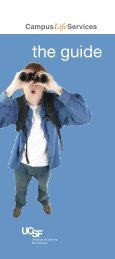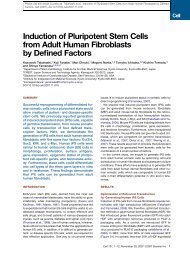ucsf benioff children's hospital helipad - University of California, San ...
ucsf benioff children's hospital helipad - University of California, San ...
ucsf benioff children's hospital helipad - University of California, San ...
You also want an ePaper? Increase the reach of your titles
YUMPU automatically turns print PDFs into web optimized ePapers that Google loves.
Facts About UCSF Medical Center at Mission Bay:<br />
UCSF BENIOFF CHILDREN’S HOSPITAL HELIPAD<br />
NEED FOR HELIPAD<br />
To mitigate the noise impact on UCSF’s residential<br />
neighbors, the <strong>helipad</strong> will be atop the outpatient<br />
building at 4 th and 16 th Streets, at the opposite end <strong>of</strong><br />
the UCSF Beni<strong>of</strong>f Children’s Hospital.<br />
• UCSF Beni<strong>of</strong>f Children’s Hospital provides a vast array <strong>of</strong><br />
expert care – from routine immunizations to the most<br />
advanced treatments for serious, life-threatening<br />
childhood diseases. This expertise is available to the<br />
children <strong>of</strong> <strong>San</strong> Francisco, <strong>California</strong> and beyond.<br />
• Rapid access to this specialized level <strong>of</strong> care is vital when<br />
a child is critically ill, a baby is born with a devastating<br />
birth defect, or a pregnant woman or her child (still in the<br />
womb) is in danger due to a serious illness or condition.<br />
• Community <strong>hospital</strong>s are not able to provide the level <strong>of</strong><br />
resources and number <strong>of</strong> pediatric specialists available at<br />
UCSF Beni<strong>of</strong>f Children’s Hospital.<br />
• The <strong>helipad</strong> at Mission Bay will provide more immediate access for the most critical <strong>of</strong> these children.<br />
Speeding the UCSF transport team to a remote <strong>hospital</strong> and airlifting patients to UCSF will save many lives.<br />
• In addition, the <strong>helipad</strong> will also benefit other patients at the <strong>hospital</strong>, even though they may not need to use<br />
it themselves. Having this valuable resource, which is standard at many <strong>hospital</strong>s outside <strong>of</strong> <strong>San</strong> Francisco,<br />
will help attract and retain top-notch medical students, residents, physicians and staff. This expertise<br />
benefits all patients who come to the <strong>hospital</strong> by any means <strong>of</strong> transport.<br />
USE OF HELICOPTER TRANSPORT<br />
• Helicopter access to UCSF Children’s Hospital at Mission Bay will be limited to the most critical and lifethreatening<br />
situations.<br />
• Examples <strong>of</strong> patients who would require helicopter transport include:<br />
‣ A newborn with a life-threatening heart defect that requires immediate surgery to survive.<br />
‣ A child with septic shock and organ failure who may die within hours.<br />
‣ A pregnant woman with severe preeclampsia threatening her life and the life <strong>of</strong> her baby.<br />
• Helicopter transport will require a physician’s approval before the helicopter is dispatched.<br />
• All patients with less serious conditions will be transported by ground ambulance or, for longer distances, by<br />
airplane ambulance.<br />
________________________________________________________________________________________________________________________________________<br />
UCSF Beni<strong>of</strong>f Children’s Hospital at Mission Bay Helipad Fact Sheet 1<br />
Contact: Holly.Houston@<strong>ucsf</strong>medctr.org or 415-241-5021 ♦ Updated 2/16/11
SAFETY<br />
• The safety <strong>of</strong> our patients, transport teams and community members is UCSF’s top priority.<br />
• The UCSF Children’s Hospital transport program has an excellent safety record.<br />
• Because UCSF is not a trauma center, UCSF is able to consider distance, weather and patient condition<br />
before determining the best mode <strong>of</strong> transport: airplane, helicopter or ground.<br />
• UCSF plans to define pre-established safety criteria, such as which weather conditions must exist in order to<br />
take <strong>of</strong>f or land at UCSF, with contracted medical helicopter transport companies.<br />
• The primary flight path to UCSF Medical<br />
Center at Mission Bay is almost entirely over<br />
the bay.<br />
• Statistics from UCSF Medical Center at<br />
Mission Bay Environmental Impact Report:<br />
Out <strong>of</strong> 8 million medical helicopter flights in<br />
the United States from 1991 to 2007, none<br />
have caused deaths or serious injuries to<br />
persons not on the helicopter. Recent medical<br />
helicopter accidents in the United States<br />
through December 2010 have not resulted in<br />
deaths to persons not on the helicopter.<br />
HELIPAD SITE PLANNING PRINCIPLES<br />
Helipad site planning for the UCSF <strong>hospital</strong><br />
complex site is guided by a number <strong>of</strong> objectives,<br />
including the desire to minimize impacts on the<br />
community and to comply with Federal Aviation<br />
Administration (FAA) requirements. UCSF has<br />
sought to minimize the impact <strong>of</strong> helicopter flights<br />
on nearby residences by:<br />
A helicopter flight test was conducted in partnership with the<br />
Mission Bay community in October 2007.<br />
• Developing flight paths that are over <strong>San</strong> Francisco Bay to the extent possible.<br />
• In response to community feedback, changing the proposed location <strong>of</strong> the <strong>helipad</strong> by moving it as far<br />
north as possible on the proposed <strong>hospital</strong> buildings.<br />
• Placing the elevator shaft to the south <strong>of</strong> the landing pad to deflect sound away from the Dogpatch<br />
neighborhood.<br />
ALTERNATIVE HELIPAD LOCATIONS<br />
UCSF is locating the <strong>helipad</strong> on the <strong>hospital</strong> site. Locating the <strong>helipad</strong> <strong>of</strong>f-site would require transporting<br />
patients from the <strong>helipad</strong> to the <strong>hospital</strong> via ambulance, which would delay potentially lifesaving medical<br />
treatments. Ground transport also adds additional risk to patients due to extra maneuvering and additional<br />
transfers <strong>of</strong> patients and intensive care equipment from the helicopter into the ambulance, then out <strong>of</strong> the<br />
ambulance again.<br />
PROPOSED FLIGHT PATHS<br />
Proposed flight paths are described below, and on the map. Given wind conditions in the area, the vast<br />
majority <strong>of</strong> flights would use the primary arrival and departure route and the alternative departure routes, with<br />
flights arriving from and departing over <strong>San</strong> Francisco Bay:<br />
• There will be no arrivals from or departures to the south toward Dogpatch neighborhood residences.<br />
• Primary arrival and departure route − helicopter arrives from the east and departs to the east over the Bay.<br />
• Alternative departure routes − helicopter arrives from the east and departs to the north before turning east;<br />
or helicopter arrives from the east and departs to the west before turning north and then east.<br />
________________________________________________________________________________________________________________________________________<br />
UCSF Beni<strong>of</strong>f Children’s Hospital at Mission Bay Helipad Fact Sheet 2<br />
Contact: Holly.Houston@<strong>ucsf</strong>medctr.org or 415-241-5021 ♦ Updated 2/16/11
• Secondary arrival and departure route − helicopter arrives from the east and departs to the west; used only<br />
in unusual circumstances when wind patterns require departure to the west.<br />
ESTIMATED TRANSPORTS PER DAY<br />
The UCSF Medical Center at Mission Bay Environmental Impact Report (EIR), certified by the UC Board <strong>of</strong><br />
Regents in September 2008, analyzed a <strong>hospital</strong> <strong>helipad</strong> at the project site. The EIR analysis assumed 1.4<br />
transports on an average day; and three transports on a busy day (a transport involves a landing and a take<strong>of</strong>f,<br />
and is therefore two flights). Projected transports are as follows:<br />
Projected Annual Transports:<br />
500 per year<br />
Projected Monthly Transports: 40 per month<br />
Projected Daily Transports: 1.4 per day<br />
These projections are well within the average for other children’s <strong>hospital</strong>s that are not trauma centers, and<br />
include neonatal, pediatric and maternal patients.<br />
HELICOPTER DAILY AVERAGE ARRIVAL TIMES<br />
7 a.m. to 3 p.m. 0.58 per day (42%)<br />
3 p.m. to 11 p.m. 0.55 per day (40%)<br />
11 p.m. to 7 a.m. 0.25 per day (18%)<br />
As indicated in the average times above, most flights are expected to take place between 7 a.m. and 11 p.m.,<br />
but other flights may be necessary based on urgent patient needs. <strong>California</strong> Public Utilities Code 21662.4<br />
exempts “emergency aircraft flights for medical purposes” from laws restricting arrival and departure times.<br />
________________________________________________________________________________________________________________________________________<br />
UCSF Beni<strong>of</strong>f Children’s Hospital at Mission Bay Helipad Fact Sheet 3<br />
Contact: Holly.Houston@<strong>ucsf</strong>medctr.org or 415-241-5021 ♦ Updated 2/16/11
HELICOPTER NOISE<br />
• Conditions affecting noise: angle <strong>of</strong> descent, wind direction, cloud cover.<br />
• Estimated flight time from shoreline to pad (including landing): 1-2 minutes.<br />
• Estimated descent-to-landing and ascent-to-departure time – 30 seconds.<br />
• Engine run time on <strong>helipad</strong> dependent on helicopter type, but in general:<br />
‣ 30 seconds to 2 minutes after landing.<br />
‣ 30 seconds to 2 minutes before take<strong>of</strong>f.<br />
‣ Engines <strong>of</strong>f for the remainder <strong>of</strong> pad time.<br />
• Hovering, which can be one <strong>of</strong> the noisiest helicopter flight activities, is not part <strong>of</strong> a routine <strong>helipad</strong> landing.<br />
The UCSF Medical Center at Mission Bay EIR included analysis <strong>of</strong> helicopter noise relative to two key metrics:<br />
• Community noise equivalent level (CNEL), which considers a 24-hour time period. Analysis using CNEL<br />
determined helicopter noise impacts to be less than significant: The area <strong>of</strong> potential impact is entirely<br />
contained on the <strong>hospital</strong> site and the UCSF research campus.<br />
• Single event noise exposure level (SENEL), which relates to a single event such as helicopter arrival or<br />
departure. Analysis using SENEL determined helicopter noise impacts to be significant due to the potential<br />
awakening <strong>of</strong> about 10% <strong>of</strong> residents within a 95-decibel noise contour, which extends about one block<br />
south <strong>of</strong> the project site to 18th Street, generally between 3rd and Indiana Streets.<br />
The EIR identified a number <strong>of</strong> mitigation measures to reduce noise impacts, including continuing to work with<br />
the community to develop a residential sound reduction program. This community process took place in late<br />
2008 and early 2009, yielding the Residential Sound Reduction Program for Helicopter Operations (RSRP),<br />
which was developed in response to community feedback. Please see RSRP Community Process Summary<br />
[PDF] for more information on the program.<br />
COMMUNITY INVOLVEMENT<br />
• UCSF has conducted a number <strong>of</strong> community meetings to answer neighbors’ questions about the <strong>helipad</strong>.<br />
• Medical transport staff, pilots and helicopter noise consultants have participated in meetings with neighbors<br />
to answer questions and to discuss how other communities are managing their relationships with <strong>hospital</strong><br />
<strong>helipad</strong>s.<br />
• Helicopter flight test: In response to a request by Mission Bay neighbors, UCSF conducted a helicopter flight<br />
test on October 21, 2007, and gathered noise measurement data from seven different locations. The data<br />
were used to inform the EIR for the UCSF Medical Center at Mission Bay.<br />
• UCSF worked with neighbors to develop a Residential Sound Reduction Program for Helicopter Operations<br />
A HELICOPTER WILL NOT BE USED FOR<br />
• Trauma scene transport (e.g., victims <strong>of</strong> a car accident).<br />
• Routine transport <strong>of</strong> stable patients.<br />
• Transport <strong>of</strong> patients from UCSF to other facilities.<br />
• Transport <strong>of</strong> staff, administrators or other non-patient-related travel.<br />
DISASTER RESPONSE<br />
An established <strong>helipad</strong> and protocols for its use in a disaster will benefit <strong>San</strong> Francisco and the greater Bay<br />
Area. These plans would be a vital part <strong>of</strong> the disaster response plan for UCSF Beni<strong>of</strong>f Children’s Hospital, as<br />
well as for the City and County <strong>of</strong> <strong>San</strong> Francisco.<br />
APPROVALS<br />
• The Regents <strong>of</strong> the <strong>University</strong> <strong>of</strong> <strong>California</strong> approved the UCSF Medical Center at Mission Bay project’s<br />
design, budget and EIR in September 2008.<br />
• UCSF obtained an FAA airspace determination in December 2008 to ensure that the proposed flight paths<br />
are clear <strong>of</strong> obstructions and to meet dimensional requirements, prior to requesting approval by Caltrans.<br />
• The UC Office <strong>of</strong> the President approved <strong>helipad</strong> operations and the RSRP in April 2009.<br />
• During its July 28, 2009 meeting, the <strong>San</strong> Francisco Board <strong>of</strong> Supervisors unanimously approved a<br />
resolution allowing <strong>helipad</strong> operations at UCSF Medical Center at Mission Bay.<br />
• On November 24, 2009, the <strong>California</strong> Department <strong>of</strong> Transportation (Caltrans) aeronautics division issued<br />
a Heliport Site Approval Permit authorizing construction <strong>of</strong> the <strong>helipad</strong> at UCSF Medical Center at Mission<br />
Bay.<br />
________________________________________________________________________________________________________________________________________<br />
UCSF Beni<strong>of</strong>f Children’s Hospital at Mission Bay Helipad Fact Sheet 4<br />
Contact: Holly.Houston@<strong>ucsf</strong>medctr.org or 415-241-5021 ♦ Updated 2/16/11


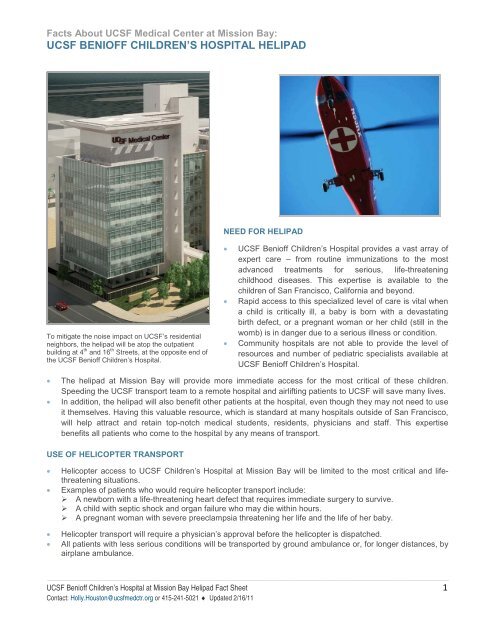
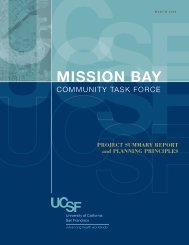
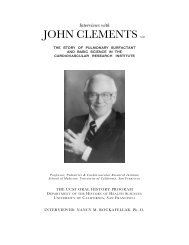
![UCSF Mt. Zion Parking Garage DEIR [PDF] - University of California ...](https://img.yumpu.com/27446936/1/190x245/ucsf-mt-zion-parking-garage-deir-pdf-university-of-california-.jpg?quality=85)




